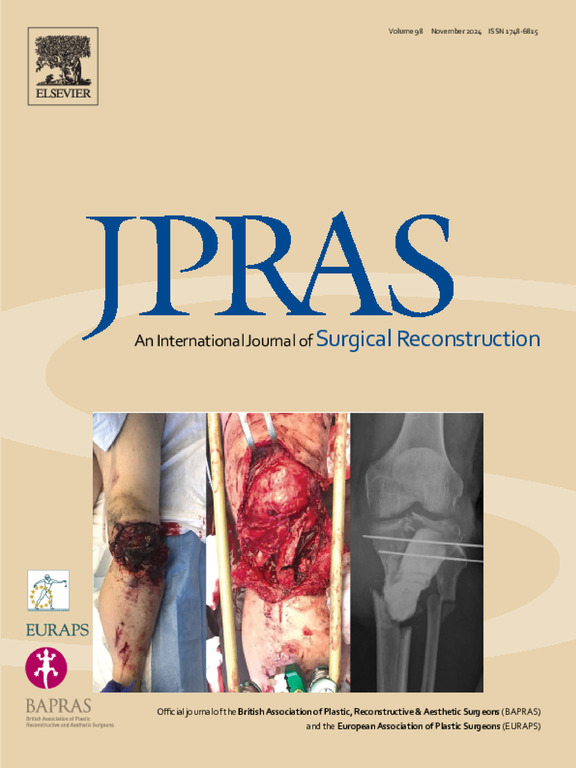“淋巴-淋巴桥”技术:在超显微外科淋巴-静脉吻合中最大限度地提高淋巴引流
IF 2.4
3区 医学
Q2 SURGERY
Journal of Plastic Reconstructive and Aesthetic Surgery
Pub Date : 2025-06-25
DOI:10.1016/j.bjps.2025.06.013
引用次数: 0
摘要
近端淋巴-孔窝吻合(LVA)实现上肢减压;然而,这一区域的受体静脉通常较深,相对于小淋巴管(lv)口径大得不成比例。造成的尺寸不匹配常常迫使外科医生放弃多个lv的吻合术,破坏引流,目前没有技术可靠地解决这一限制。我们开发了淋巴淋巴桥(LLB),这是一种顺序端侧方法,使用相邻的左室作为自体导管,将其他无法到达的左室连接到单个受体静脉。LLB被添加到>;当lv距离较远或尺寸较小时,有2,800个lva。该手术避免了额外的切口或静脉移植,并可增强顺行冲洗,同时减少静脉回流。初步随访结果显示肢体体积减少与标准LVA相当。通过合并额外的近端LVA, LLB拓宽了近端LVA的适应症,并可能增加淋巴压力,从而改善早期通畅。这些发现支持LVA手术的近端优先策略,并保证前瞻性对照评估。本文章由计算机程序翻译,如有差异,请以英文原文为准。
The “lymphatico-lymphatic bridge” technique: Maximising lymphatic drainage in challenging scenarios in supermicrosurgical lymphaticovenous anastomosis
Proximal lymphaticovenous anastomosis (LVA) achieves superior limb decompression; however, recipient veins in this region are often deep and disproportionately large in caliber relative to small lymphatic vessels (LVs). The resulting size mismatch frequently forces surgeons to forgo anastomoses with several LVs, undermining drainage, and no current technique reliably resolves this constraint.
We developed the Lymphatico-Lymphatic Bridge (LLB), a sequential end-to-side method that uses an adjacent LV as an autologous conduit, linking otherwise unreachable LVs to a single recipient vein. The LLB was added to > 2,800 LVAs when LVs were distant or undersized.
The procedure avoids extra incisions or vein grafts and may enhance antegrade washout while reducing venous reflux. Preliminary follow-up results show limb-volume reduction comparable to that of standard LVA.
By incorporating additional proximal LVs, the LLB broadens indications for proximal LVA and may augment lymphatic pressure, thereby improving early patency. These findings support a proximal-first strategy for LVA surgery and warrant prospective controlled evaluation.
求助全文
通过发布文献求助,成功后即可免费获取论文全文。
去求助
来源期刊
CiteScore
3.10
自引率
11.10%
发文量
578
审稿时长
3.5 months
期刊介绍:
JPRAS An International Journal of Surgical Reconstruction is one of the world''s leading international journals, covering all the reconstructive and aesthetic aspects of plastic surgery.
The journal presents the latest surgical procedures with audit and outcome studies of new and established techniques in plastic surgery including: cleft lip and palate and other heads and neck surgery, hand surgery, lower limb trauma, burns, skin cancer, breast surgery and aesthetic surgery.

 求助内容:
求助内容: 应助结果提醒方式:
应助结果提醒方式:


